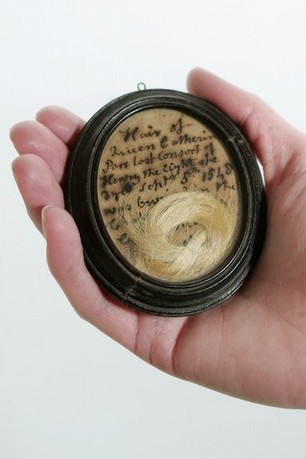
In the aftermath of Katherine Parr’s passing, Lady Elizabeth Tyrwhitt, one of her closest friends, recalled, “Two days afore the death of the Queen, at my coming to her in the morning, she asked me where I had been so long, and said unto me, she did fear such things in herself, that she was sure she could not live. Whereunto I answered, as I thought, that I saw no likelihood of death in her. She then having my Lord Admiral by the hand, and divers others standing by, spake these words, partly, as I took it, [in delirium], ‘My Lady Tyrwhitt, I am not well handled, for those that be about me careth not for me, but standeth laughing at my grief, and the more good I will to them, the less good they will to me.’”

A few days earlier, on 30 August, 1548, at Sudeley Castle, Gloucestershire, 36-year-old Katherine had given birth to her first child. She and her most recent husband, Lord Admiral Thomas Seymour, named the healthy baby girl after Katherine’s adult stepdaughter, Princess Mary Tudor. Despite the polar opposition of their religions—Mary was a devout Catholic and Katherine an evangelical Protestant—the two were close.
Not present as Katherine’s condition degenerated was her second royal stepdaughter, Princess Elizabeth, who had lived at Sudeley with the Queen. The reason why was tied to what Lady Tyrwhitt heard the feverish Katherine say to the Lord Admiral. Seymour had sexually harassed, if not actually molested, Elizabeth on multiple occasions. Unfortunately, Katherine sided with the man she desperately loved and with whose child she was heavily pregnant. Elizabeth was sent away from Sudeley in disgrace, as if Seymour’s faults were her own. A rapprochement between stepmother and stepdaughter had just begun at the time of baby Mary’s birth.
![]()
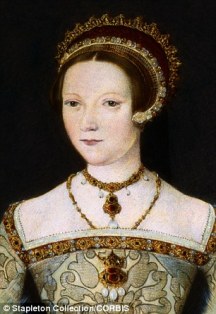
Katherine Parr’s storied life began in Blackfriars, London, sometime in August 1512. The daughter of Sir Thomas Parr and Lady Maud Green had known King Henry peripherally for many years before he married her in 1543. Both she and her mother were ladies in waiting to his first queen, Catherine of Aragon, and Katherine appears to have served in the household of Princess Mary.
When Katherine wed the King, she had been married twice before—first, as a teenager to Sir Edward Borough, the grandson of 2nd Baron Borough of Gainsborough Hall. A year after the young man’s death in 1533, she married middle-aged John Neville, 3rd Baron Latimer of Snape Castle, North Yorkshire. In 1536, during the Pilgrimage of Grace, Snape Castle was captured by rebels and Katherine and her Neville stepchildren were held hostage and threatened with death if Baron Latimer did not acquiesce to their demands. The beleaguered Latimer saved his family, but died in 1543, leaving Katherine as a 30-year-old widow.
Slender, vital, and attractive, Katherine wanted to marry for love before her youth was lost. The man she wanted was Seymour, the brother of Henry’s third queen, Jane, who died in 1537 after the birth of Prince Edward. Instead, the widowed Lady Latimer’s hand was solicited by King Henry. He married her in July 1543 at Hampton Court.
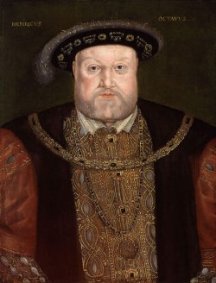
In 1544, Queen Katherine, who loved color and finery, was described by de Gante, the secretary to the Duke of Najera, thusly: “She is of a lively and pleasing appearance and is praised as a virtuous woman. She was dressed in a robe of cloth of gold and a petticoat of brocade with sleeves lined with crimson satin and trimmed with three-piled crimson velvet. Her train was more than two yards long. Suspended from her neck were two crosses, and a jewel of very rich diamonds and in her head-dress were many and beautiful ones. Her girdle was of gold with large pendants.”
Katherine, who was the last in the “divorced, beheaded, died, divorced, beheaded, survived” series of Henry’s queens, was also his second-longest legal spouse, married to him for three years and five months. The King’s first marriage to Catherine of Aragon officially lasted 24 years; he was married to Anne Boleyn just short of three (although, arguably, they had been a couple for far longer); Jane Seymour died after a little more than a year; Anne of Cleves lasted six months; and Katheryn Howard was queen for a year and a half.
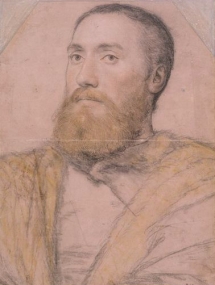
Although there is every indication that Henry and Katherine had a genuinely loving marriage, as the King’s health failed and the daily discomfort he felt ratcheted toward agony, he was convinced by the pro-Catholic faction of the court that his Queen was a dangerous heretic who plotted against him. Fortunately, a copy of the arrest warrant was leaked to Katherine by a well-wisher, and she used her quick wits to convince the King that in matters of faith, she looked only to him for answers and direction. Henry was mollified, and when the officials arrived to arrest the Queen, he berated them as “knaves and fools.” The King and his wife were perfect friends again and would remain so until he died, 28 January, 1547.
Not wasting time, the dowager queen sped into a marriage with Thomas Seymour after a widowhood of just six months. But what began in joy ended, as it so often did for women, in a slow, febrile death. Mary Seymour was a week old when the dowager queen succumbed to puerperal sepsis. Mary would die in early childhood, probably in the household of Katherine’s close friend, Catherine Willoughby, Dowager Duchess of Suffolk.
![]()

After her death, Katherine lay in repose at Sudeley for a short time, then her body was wrapped in cere—a cloth treated with wax—and placed in a form-fitting lead coffin. Into the soft lead was impressed, “KP. Here lyeth Queen Katheryne Wife to Kinge Henry the VIII and The wife of Thomas Lord of Sudely high Admy… of Englond And ynkle to Kyng Edward VI.” Miles Coverdale preached a sermon and Lady Jane Grey was the chief mourner at the funeral, which is believed to be the first protestant service of its kind in England. Afterward, the Queen was buried within the chapel.

Katherine rested beneath Sudeley Chapel for well over two centuries. But as the estate and church went to ruin above her, she remained largely unchanged, as was pronounced in an account by a Mr. Brookes of Reading of the opening of the Queen’s grave in the late 18th Century. This was provided to the Transactions of the Cumberland and Westmoreland Antiquarian and Archeological Society, Vol. XIII (1895) by Brookes’ niece.
In the summer of the year 1782, “Mr. John Lucas (who occupied the land of Lord Rivers, whereon the ruins of the chapel stand) had the curiosity to rip up the top of the coffin, expecting to discover within it only the bones of the [Queen], but to his great surprise found the whole body wrapped in 6 or 7 seer cloths of linen, entire and uncorrupted, although it had lain there upwards of 230 years. His unwarrantable curiosity led him also to make an incision through the seer cloths which covered one of the arms of the corps, the flesh of which at that time was white and moist. I was very much displeased at the forwardness of Lucas, who of his own hand opened the coffin. It would have been quite sufficient to have found it; and then to have made a report of it to Lord Rivers or myself.”
It was probably at this time that hair clippings and a swatch of fabric from the sleeve of Katherine’s burial dress were taken.
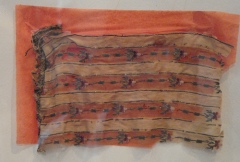
The account continued, “In the summer of the year following 1783, his Lordship’s business made it necessary for me and my son to be at Sudeley Castle, and on being told what had been done the year before by Lucas, I directed the earth to be once more removed to satisfy my own curiosity; and I found Lucas’s account of the coffin and corps to be just as he had represented them; with this difference, that the body was then grown quite fetid, and the flesh where the incision had been made was brown, and in a state of putrefaction; in consequence of the air having been let in upon it. The stench of the corps made my son quite sick, whilst he copied the inscription which is on the lead of the coffin; he went thro’ it, however, with great exactness. I afterwards decided that a stone slab should be placed over the grave to prevent any future and improper inspection, &c.”
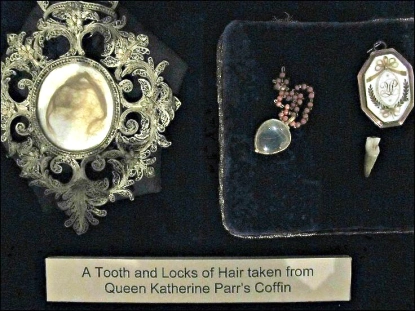
This was not the last time that the corpse was disturbed. In 1792, her coffin was dug up by drunken revelers and reburied upside down. Twenty-five years later, Lord Chandos, who then owned Sudeley, wanted to move Katherine to a safer tomb. The exhumation was done by Rev. John Lates, who had undertaken the repair of the chapel, and Edmund T. Browne, a Winchcombe antiquary, whom, Transactions notes, wrote of this discovery on 18 July, 1817.

Browne reported that “after considerable search…the coffin was found bottom upwards in a walled grave, where it had been deposited…. It was then removed to the Chandos vault, and…we proceeded to examine the body; but the coffin having been so frequently opened, we found nothing but the bare skeleton, except a few pieces of sere cloth, which were still under the skull, and a dark-coloured mass, which proved to contain, when washed, a small quantity of hair which exactly corresponded with some I already had. The roots of the ivy, which you may remember grew in such profusion on the walls of the chapel, had penetrated into the coffin, and completely filled the greater part of it….
“We then had the different pieces of lead, which from time to time had been cut from the coffin, firmly nailed together, so as to present the original form of the coffin, and it was placed on two large flat stones by the side of that of [the former] Lord Chandos. Dr. Nash said, ‘The Queen must have been low of stature, as the lead which enclosed her corpse was but five feet four inches in length.’” Actually, a height of about 5 ft. 4 in. was considered middling for a woman of the 1500s and accords well with a woman who, when live, was neither described as tall or small.
Browne concluded, “The ancient chapel, which had been desecrated by the Puritans, was thoroughly renovated under the direction of Sir John Gilbert Scott, and a handsome decorated altar-tomb, surmounted by a gothic canopy, was erected on the north side of the Sacrarium to the memory of Queen Katherine Parr, whose effigy was rendered as correctly as it could be from the portraits which are extant.”
Safe under the alabaster image that returned stone flesh to her bared bones, Queen Katherine Parr’s restful eternity had at last begun.
Ω


Quite fascinating!
LikeLiked by 1 person
Really? Why do you say that?
LikeLike
What a hopping life she lived. I didn’t remember that she was so young when she died. I’m sure you’d told me before but my brain stuck on the word ‘widow’ and I imagined her as an older person. It’s a bit surprising, too, that her first child came from her fourth marriage. I can discount Henry VIII, and her elderly second husband as well, but her first husband was young. Just curious, that’s all.
LikeLiked by 1 person
i thought the same re it being her first child!
LikeLiked by 1 person
Lovely to read. I am fascinated by the blondness of the hair – as you point out, the portraits don’t reflect that.
LikeLiked by 2 people
I’ve read a lot about the “six wives,” but didn’t know a lot of this about Katherine.
LikeLiked by 1 person
It occurred to me that if only the coffin had not been opened until the 1820’s (40 years after it was first opened….then it would have been possible to have a photograph of one of the wives of Henry VIII). Imagine that! Presumably if the flesh on the arm was intact and not decomposing, so too would the face have been intact. Paintings vary so much in their depictions. Such a pity people interfered.
LikeLiked by 1 person
The face was intact. Supposedly one of the men kissed her and proclaimed that they had now kissed a queen. I agree that it would have been amazing if this find had been made after photography and by archeologists and not idiots! LOL.
LikeLike
Interesting. A few years back I posted the same comment somewhere online , about the daughter of Marie Antoinette. She actually survived the revolution, but with so much emphasis on her mother I doubt many people even know about her. I have a biography I found on Amazon. Anyway, she was alive after 1820. I don’t know, but I highly doubt any photos were taken. Imagine a photographic image of Marie Antoinette’s daughter too !!!! Augh ! If only !
LikeLike
The portraits currently posted are not of K. Parr
LikeLike
Yes, in fact, they are.
LikeLike
I don’t think any of the portraits you posted are of K. Parr !
LikeLike
Yes, indeed, the certainly are.
LikeLike
Hi
OK you’d know better than I about that. The reason I thought they weren’t of K. Part is because the portrait of her in a grayish colored dress is either very similar or the exact same portrait that was identified elsewhere online and I think on a book cover as Lady Jane Grey/Gray.
LikeLike
I’d like to correct my post ! I accidentally wrote “Katherine Part”! Auto correct, augh ! Katherine PARR !
🙂
LikeLike
It’s weird how in all of her portraits she either has medium brown hair or reddish dark brown hair but in all of the supposed cuttings of her hair that were taken her hair almost looks bleach blonde especially in this one… i’ve heard quite a lot that with time hair cuttings can change color (due to bacteria, the natural aging process, the natural process that breaks down our bodies after we die, fungi, temperature it’s stored in, how well it’s stored and other outside factors) but it’s always gotten darker not lighter… since a lot of the portraits of Catherine are verified as being done in her lifetime meaning it’s safe to assume that it’s accurately depicting her (maybe Catherine decided to have herself painted with darker hair instead of with her natural blonde color but at the time blonde hair was seen as the most attractive on a woman so her doing that wouldn’t make much sense) I wonder if all the supposed cuttings of Catherine’s hair is actually her hair and not someone else’s 🤔 Honestly as much as I wanna believe that it is her hair I don’t think it is since it’s a completely different color (like night and day) then what’s shown in all of her portraits. We could say that maybe the portraits due to age changed from what they originally looked like but usually that causes different shades of the original color (meaning if it was originally a bleach blonde color it might look like a ash blonde color maybe a very light brown at worst) and with how dark her hair is in some of those portraits there’s no way it changed from natural bleach blonde to dark brown. Sadly there’s no way to prove for certain if it is or isn’t her hair because 1.) we’d have to pull DNA from her remains (and would have to confirm that they’re actually her remains which would add another hurdle) and from her supposed hair and compare them to see if they match but we don’t have her DNA on hand and there’s no way in h*ll we’d ever get permission to exhume her to extract DNA especially not to just prove if a hair clipping is hers or not 2.) the only way to pull DNA from hair is by having an intact root (the part that’s in your skin meaning there’s skin cells attached and other miroscopic pieces of our bodies we can get DNA from) but all of her supposed hair was cut not pulled (which is how you get an intact root or by it naturally falling out) so finding any pieces that have roots is slim to none and finally 3.) even if by some miracle we were given permission to exhume her remains and managed to find a piece of her supposed her with an intact root Catherine died almost 500 years ago… the second we die our bodies immediately start breaking down and destroying DNA so actually being able to successfully pull DNA from her really old remains and her really old supposed hair would be extremely hard. Even if her remains and her supposed hair were in great condition for their age getting a good sample would be really hard. It’d be a hit or a miss.
LikeLike
After so many centuries it’s likely possible the hair that was saved simply faded out. And changed in color.
LikeLike
I am related to Katherine Parr through my Mom’s Throckmorton heritage and I am just now finding out and researching about her. I am so angry with the desecration of her body by wicked men. I can’t believe people would do the things they did to her body and not show the proper respect due to her not only as Queen but also as God’s instrument to solidify the Reformation in England. I am glad there is a place for her now for people to go and visit. Calvin was buried in an unmarked grave and Luther is buried in the floor of Castle Church in front of the alter. Most people are unaware of Katherine’s importance in history and protestant her influence on Elizabeth I while raising her, changing the world. Rest in peace dear Katherine until the resurrection of the body from dust to your soul with Christ’s return when true Christians will be rewarded for their works. The wicked will pay at the second resurerction for the things they did!
LikeLike
Ugg
LikeLike